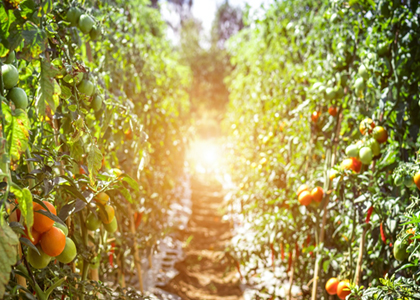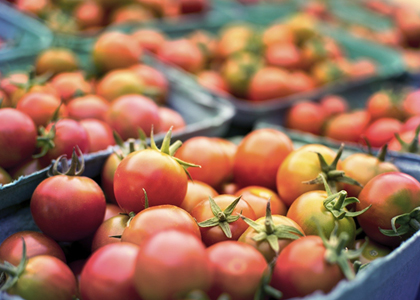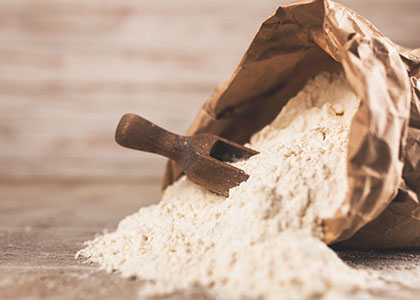Home / Blog / 3 ways your agricultural business can cut costs
SUMMARY
Running a farming business requires commitment and passion, but passion doesn’t necessarily translate into profitability. If your agribusiness is having trouble turning a profit, it might be time to look at cutting some of your farming costs. This article suggests short and long-term solutions that can make this possible.
Whether you choose to conserve by making the most of existing resources, opt to increase workflow efficiencies across farming processes, or make better decisions by using smart data, it makes sense to be prudent with finances given the unpredictability of this year.
One suggestion that may help you weather tough times is to use data wisely when deciding where cuts can be made across your enterprise. With advances in agricultural technologies, you can now trace the metrics of your farm and its overall performance. By tracking crops and chemical balances in soil against the costs of inputs, you can use data to your advantage to make smarter decisions.
INDEX
- Data management solutions
- Increase workflow efficiency across farming processes
- Conserve existing resources
3 WAYS YOUR AGRICULTURAL BUSINESS CAN CUT COSTS
Running and managing an agricultural business requires planning. Farms are costly enterprises with many coordinating parts and multiple supply chains. They are also especially susceptible to unforeseen factors, like weather disturbances and pest attacks, all of which can affect profitability. Whilst you may not be able to determine a crop’s yield, you can control processes that can go a long way in helping you cut costs.
This article highlights three approaches through which a farm can reduce expenses.
- Data Management Solutions

Agribusinesses require a lot of planning. Gone are the days when things could be done ad hoc. Even small-scale farming enterprises need to use data management solutions, technology, and digital processes to operate at a high level of professionalism. Maximizing the use of existing technologies not only optimizes processes but can also help you save money.
- Keep records for everything: Ask any business owner and they will tell you that keeping your books organized as best as you can is fundamental to the success of an enterprise. Recording all costs, like inputs purchases, equipment maintenance, farmland rents, administrative costs, etc., including relevant information like dates, suppliers, raw material costs, and consultancy fees, can help you spot large expenditures quickly. When it comes to cost-cutting you will need to review these bulky expenses to decide what you can do without and what you need to keep.
- Use a digital management system: Whilst everything can’t be predicted on a farm, planning your agribusiness on a management system can greatly control costs as it helps you keep a tab on expenses. Forget notebooks and instead use software that allows detailed record-keeping of all farm operations. Digital databases allow for a quicker review of information, as well as identify trends faster and more efficiently. Similarly, deciding in advance and tracking what areas of business you will be investing in, the crops you’ll be growing, the space allocated for each of them, and the agrochemicals and other products you’ll be needing can give you a macro picture of what your expected expenses are likely to be. By focusing on the numbers and doing a cost analysis of everything, you know where your business stands at any given time. This helps you analyze operations and see if you’re making improvements, competing, or falling behind. When you have a view of the bigger picture, you can carefully plan finances and optimally choose areas of your business that can take a cost-cutting.
- Record all relevant variables: Technology can help you when it comes to controlling costs, whether it’s by allowing easy record-keeping, or by providing reports and insights. It does of course require a commitment to using the software regularly. Using data from digital technologies like GPS, auto-irrigation systems, and sensors to tabulate seeding rates or fertilizer consumption can help you zone in on the specific needs of an area or a crop. This means you are using supplies more accurately and not wasting anything.
- Incorporate agricultural automation: Gone are the days where you can operate a farming business like your forefathers before you. As all industries innovate, agriculture has to automate to deliver a higher level of professionalism. Digitalizing agriculture through remote sensors, satellites, and UAVs automates processes for smarter precision. Not only do these practices monitor plant health, soil condition, temperature, humidity, etc., but they also generate data that can help farmers gain a better understanding of the situation on the ground to plan agricultural needs more efficiently. Sensors in irrigation lines and in the soil can identify leaks or adjust water cycles to reduce waste as well as costs.

- Increase Workflow Efficiencies Across Farming Processes
As we have mentioned above, agricultural businesses are a sum of many moving parts. From sourcing the right kind of supplies, managing materials optimally through every stage of the crop growth cycle, to timely harvesting and supplying products to markets for sale without wastage, each stage of the agribusiness cycle is critical to success. Keeping a close eye on the big picture not only increases efficiencies but can also help reduce expenses.
Below we suggest ways how you can do this:
- Partner with a reliable supplier: Agricultural commodities and supplies have a lot of influence on the total expenditure of a farm. Partnering with a reliable and professional supplier means that you never lose time in waiting for materials. It also ensures that stocks are managed with greater care to avoid waste and unnecessary costs. Combined with regularly updated record-keeping, a professional supplier can help you map out farm activities for each crop’s productive cycle, maintain a record of undertakings, and manage supplies for maximum utility. By optimizing workflows, you ensure that there is no wastage.
- Ensure smarter pest management:

If you are looking to cut costs you need to evaluate your farm’s chemical requirements. As farmers are very often spending too much on chemicals, pesticides, and herbicides, it pays to analyze and research generic chemical alternatives, evaluate guarantees/warranties when purchasing, and be wary of promotions that look too good to be true as they can end up causing more damage than good. Ensure that you’re getting a good deal and don’t be fooled into thinking that the more expensive mode of action is the best.
You may also want to consider some of the following pest management practices to help you reduce expenses:
- Weeds: It is advisable to choose a weed management program to fit a specific You may want to check preemptive spraying if you are trying to save costs, and only consider management of resistant varieties. You can also save money and supplies by switching from a custom application to doing your own spraying.
- Insects: Similarly, with insects, it is advisable to ramp up scouting, and base treatments on thresholds. Scout for damage rather than spraying preventively and pencil in costs for insects that may be a problem later. For example, if you have a problem fighting resistant rootworm, you may be able to switch to a cheaper non-stacked corn variety and apply a soil insecticide.
- Disease: With a plant disease, it is advisable to use all the tools available to you as a spread can cause widescale damage. The biggest disease-management tool is hybrid selection. Selecting resistant plant varieties up front can save you on repeat expenses through the growth cycle. Rotate crops and avoid blanket preventive fungicide applications without scouting.
- Vary nitrogen application: Efficient use of nitrogen can increase crop yields by 22%. Nitrogen is the key element needed for good plant growth, but it is expensive to buy. Varying nitrogen application and reducing loss, therefore, is an efficient way to cut costs. A variable-rate controller and technology like smart sensors can monitor weather, nitrogen loss from the soil and calculate crop needs and timings for more targeted and precise application. You can also try and reduce nitrate loss on your farm with saturated buffers, which can mitigate 41% to 98% of the nitrate concentration being lost. As an affordable and effective edge-of-field conservation method, saturated buffers are designed to treat tile drainage water from fields that are adjacent to rivers, streams, lakes, and ditches. The saturated buffer intercepts a field tile and redistributes the water through a buffer strip’s soil profile. As the water drains through the soil profile, perennial plants take up the excess nutrients. This allows you to reduce nitrogen waste from the field, whilst retaining moisture in the ground.
- Targeted fertilizer application: In times of input trimming, it is advisable to execute a fertilizer management approach that prioritizes resources to just maintaining existing crop yields. Similar to varying nitrogen applications based on requirements, soil tests can help you determine where you can cut fertilizer expenses without sacrificing produce. Another approach to temporarily scale back fertilizer costs is to reduce broadcast applications for a few years in areas where soil test levels are optimum. In soil that is sub-optimal, you might want to establish a fixed amount you are willing to spend on nitrogen, phosphorus, potassium, and lime, and use a soil test to decide where you can cut back. Alternatively, you can set the amount for one farm and adjust from field to field. It does, however, pay to keep in mind that for newly cultivated farmland with low fertility, it’s impossible to reduce fertilizer cost simply by setting a target based on total expenditure. You may have to consider scaling back your yield goal. And if that doesn’t work, you can try and boost fertilizer efficiency. Applying phosphorus and potassium as a starter fertilizer gives you a temporary margin to get away with lower amounts without affecting crop growth during the critical early stages.
- Lower seed costs: For farmers looking to cut costs, early ordering of seeds can produce significant savings. Many farmers tend to buy relatively small quantities of seeds from several different suppliers. You may not realize it but too much diversification of seed purchases may be costing you! Ordering large volumes from a few dealers benefits you from economies of scale. What’s more, a professional supplier may also be able to offer additional savings if you purchase seeds, herbicides, and fertilizers together.
- Change your rotation schedules: Research in the US has shown that there are many advantages to rotating crops on the same area of land. Not only does it reduce fossil fuel expenses, but the soil is also healthier, better in structure, and therefore better able to hold water and absorb nutrients. Healthier soil requires lesser inputs and can save you on extra material costs.
- Plant more cover crops: Research shows that whilst cover crop seed can be expensive, cover crops can help with weed suppression and increased soil fertility. They do a great job of suppressing herbicide-resistant weeds per acre of land in the long run, as well as increase soil organic matter, reduce erosion, and allow additional economic opportunities from grazing cattle.
- Conserve Existing Resources

It makes sense for any business to conserve and utilize existing resources in a smarter way. Maintaining lower overhead costs for items such as utilities, farm insurance, machinery leases, and equipment depreciation can go a long way in saving money in the long run.
Often finding ways to reduce costs on a farming operation comes down to a daily process of asking hard questions. One way to gauge if a process is working is to determine whether or not the amount you’re investing in a crop or piece of land is meeting your expectations. Here are some ways in which you can maximize usage:
- Find the right suppliers for you and stick with them: There is always a chance that your business is missing out on a better deal when it comes to buying supplies. If you feel like you are paying too much, look at other options in the market. Do your homework and then switch to a company that works for you.
- Find out about options other than machinery upgrades: The right kind of machinery is vital to running a farm, but you don’t necessarily need to make updates and purchase new equipment all the time. Find out if your suppliers can set you up with other options like leasing or rental. You may also want to ask for consulting and advisory help, especially if you are looking for ways to get the work done without spending extra money. As they are the specialists, they are best advised to suggest options that may work for you!
- Be smart about how you use your water: Farmers have seen real value for crops when they install drip irrigation systems to stretch their water resources. With flood and gravity flow irrigation, you can also pressurize and force water across larger areas of land at a much lower cost.
- Make your own fertilizer: If you are an enterprise that also runs livestock, you can cut costs by making your own fertilizer and meet your composting requirements through an on-site facility.
- Postpone machinery upgrades: Before you invest in new machinery you need to ask yourself if it will improve your bottom line. Whilst equipment such as individual row planter clutches and variable-rate controllers might reduce seed expense and increase yield, you can delay a purchase by tackling maintenance issues on current equipment. Again, in cases like this, you need to have reliable professional support to ensure that you are not spending more by delaying upgrades.
- Invest in alternative energy sources: Admittedly, an investment in alternative energy is an upfront costly endeavor and should not be considered when a business is facing a crunch. However, investing in alternative energy solutions, like wind power and solar panels can help you reduce energy costs and increase profits in the long term. Wind turbines provide a cheaper form of energy to power farm equipment than conventionally generated electricity. Similarly, another growing trend in Saudi agriculture is the use of solar power to generate energy for water desalination. It’s helping farms like yours increase water efficiency, as well as significantly reduce irrigation costs.

Without a doubt, technology is a huge investment – in both money and time. Yet it is the only way that can intelligently map inputs against productivity to show profitable trends. With the right technology, you can compare the performance of different seed varieties to improve seed selection. So, during harvest, map and record crop yield and moisture data in real-time and drive automatic irrigation/ fertilizer/ herbicide application methods. The uses are endless.
When margins are tight, these same technologies allow farmers to gain the most accurate data that can help them control costs. Information is power. With section control, you can dial in on the inputs you’re putting on a field to avoid waste. Investing in software can manage your data efficiently to help you make better decisions, whilst integrated solutions can optimize workflows.
As Saudi sets itself a broader vision for agricultural self-reliance, it is only by riding a technological wave that we can generate real savings across agribusinesses. It is also the only way that agriculture can become sustainable in the Kingdom.
For more information on how agribusinesses can cut costs, get in touch with us or email hello@agri.com.sa.












